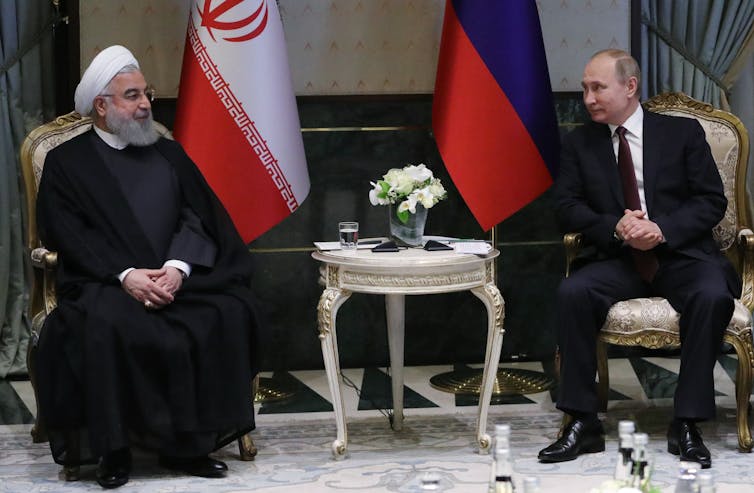
An Israeli F-16 pilot prepares for a drill. EPA/Abir Sultan
As is standard practice, Israel has not claimed responsibility for the airstrikes, but the attacks appear to be the latest in a series of operations which have targeted Iranian personnel as well as the transfer of missiles and weapons to Lebanon’s Hezbollah.
In December 2017, Israel destroyed a base near Damascus that was reportedly being developed by the Iranians. Then on February 10, 2018, Israeli warplanes struck a number of sites inside Syria. Among them was the T-4 base near Palmyra, from which an Iranian command centre was said to have operated a drone over Israeli airspace; in early April, Israel targeted the base yet again.
Israeli ministers, including prime minister Benjamin Netanyahu and his defence minster Avigdor Liberman, have accompanied the attacks with warnings that a long-term Iranian military presence in Syria will not be tolerated. Hours before the latest explosions, Liberman reiterated that: “We will maintain freedom of operation in all of Syria … We will prevent Iran from establishing a forward base in Syria at any cost.”
Iran has been instrumental in the survival of the Assad regime since the Syrian uprising began in March 2011. Since then, Israel has used its air power to disrupt weapons supplies to Hezbollah and maintain a buffer zone in the southwest, near the Israeli-occupied Golan Heights. But now it seems things are heating up. Is this now a far bigger, more direct confrontation in the Syrian arena?
The southern flashpoint
The Syrian conflict is now in its eighth year, and changing fast. Since December 2016, the Assad regime has pulled back from what looked like near collapse. Thanks to Russian airstrikes and Iranian ground forces, it has overcome the rebel presence in Syria’s largest city, Aleppo, eroded opposition territory in northwest Syria, and now wrested full control over the opposition enclave of East Ghouta near Damascus. With sieges, scorched earth operations, and chemical and incendiary attacks as well as conventional ones, the regime has finally removed the threat to its seat of power.
So far, Israel has tolerated the territorial shift in Assad’s favour, all too aware that Assad’s fall could leave a power vacuum. It can even accept that the regime is set to retain control not just of Damascus, but of much of the rest of Syria, too. That toleration has been helped by a working agreement with Russia that the conflict will not move towards the Golan Heights, a move that might well involve Iranian-led militia and Hezbollah personnel.
But now an emboldened Assad regime is looking for its next target, and it might well see one in southern Syria, where the opposition holds a belt of territory along the Jordanian border – including Daraa, the city where protests sparked the uprising in March 2011. A deescalation zone has been set up in the area, and a fragile truce is in place, but a government offensive could upend it. And even more importantly, no such offensive could be successfully pursued without the involvement of Iran’s Revolutionary Guards, leading foreign militias and Hezbollah.
The recent Israeli airstrikes already show a concern that Iran could position its proxy militias right next to the strategic Golan Heights and pose a significant challenge to Israeli national security. The southern offensive would add proximity to that worry. This is the geography behind an ominous warning Netanyahu issued in February:
Israel will not allow Iran’s regime to put a noose of terror around our neck. We will act without hesitation to defend ourselves. And we will act if necessary not just against Iran’s proxies that are attacking us, but against Iran itself.

Iran’s Hasan Rouhani meets Vladimir Putin, April 2018. EPA/Mikhail Klimentyev/Sputnik/Kremlin
The only actor that has open lines of communication with both sides is Russia. All Israeli activity in Syrian skies has been coordinated with Moscow, and Russia’s S-400 missile systems, deployed to protect its own installations, have not offered the same protection for Syrian or Iranian establishments. But Russia’s mediating position may be eroding.
Israel did not give the Russians notice of its airstrikes in early April. While Moscow grumbled, it stopped short of retaliating. But after those strikes, as well as the American-British-French ones on April 14, Russia indicated that it may finally equip Assad’s military with S-300 anti-aircraft missile systems. If Israel comes into contact with those systems, whether by seeking to destroy them or simply by carrying out air strikes in their vicinity, it could push its “deconfliction” relationship with Russia to breaking point.
Other scenarios could yet play out on the southern front. Iran could respond to Israeli airstrikes by hitting targets within Israel; Russia could withdraw its guarantees that neither Iran nor its proxies will have a lasting presence in a post-rebel south. And even if Russia tries to hold that line, its leverage with Iran may have already weakened to the point where Tehran acts without seeking Moscow’s acceptance. The choices on all sides are limited, and unless one party backs down in this standoff, a mutually destructive engagement between Iran and Israel is looming on the horizon.
On April 30, Iran’s Supreme Leader, Ayatollah Khamenei, told Iranian workers in Tehran: “Some countries in the region should know that if they face the Islamic Republic of Iran, they will definitely be hit and defeated.” The ayatollah is well-known for his bluster. So is Benjamin Netanyahu. But in Syria’s kaleidoscopic conflict, their once-empty threats may be aligning to create a war within a war.
Scott Lucas, Professor of International Politics, University of Birmingham and Umer Karim, PhD Candidate, Department of Politics and International Studies, University of Birmingham
This article was originally published on The Conversation. Read the original article.
